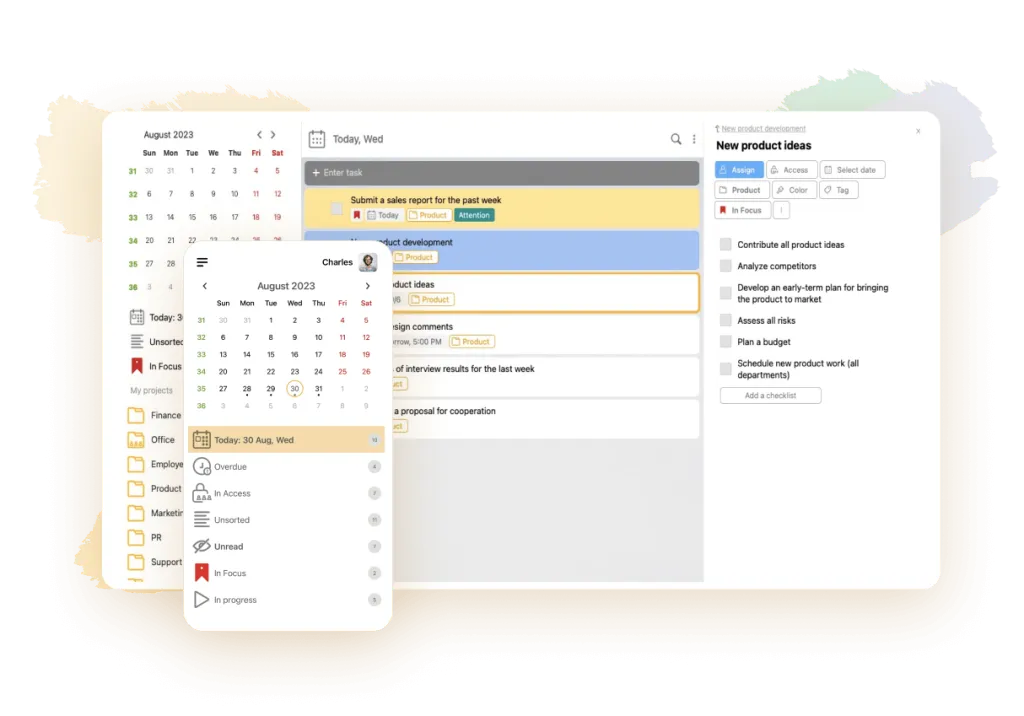
Ted Scott
March 12, 2024
All processes, goals, concepts and objects begin with ideas, which are then communicated to other people, discussed, developed, produced. And only then are they put into the public eye, where they are used by people en masse.
Project management in a manager’s activity is no exception. It too must start somewhere. And in most cases, the first stage of a future endeavor consists of building a roadmap and forming a project plan. But what does it consist of?
In this article, we will try to give recommendations and explain in detail how to properly create such a plan, why you need planning, what algorithms and strategies exist for its creation, what project planning processes you need to go through, how to bring it to completion and what instructions or tools in this matter serve as the main helpers.
What is project planning
Planning itself is a step-by-step process of creating and adopting a system of targets and identifying ways to achieve them in the most fruitful and expeditious way. These objectives often look like a tree of goals and describe the future.
Its practical importance is due to a number of reasons, the most important of which are the uncertainty of the future, the coordinating role of the plan and the optimization of economic outcomes. Planning maximizes the probability and level of achievement of objectives, based on systematic preparation of decisions.
The main technique for introducing participants to a project before work begins is its plan. Creation and further adoption of the plan by the whole working group, including the supervisor and manager, helps to better understand personal responsibility and own tasks.
What is a project plan
A coherent project plan is not a list of mechanical tasks for staff and project team members, but organization and control. The project plan shows the key themes, project objectives, the order of steps, possible difficulties and how to overcome them in the course of the activity.
During planning, the manager performs an assessment, determines the primary goals, the team of performers, contractors and distribution of tasks, and works out a schedule for accomplishing the tasks. The manager should realize that the plan will be adjusted and supplemented in the course of the activity.
Thus, the plan is created to streamline the future work of the project team and minimize risks, prescribe the responsibilities of each team member, ease of control and avoid unnecessary fuss.
Why create a plan
The need to create a plan is that it solves and covers several important tasks at once. Without it, it is unlikely to achieve much and overcome possible difficulties that will be encountered on the way to the realization of the project.
First, at the planning stage, the project itself is approved and agreed upon with the main members of the working group. Secondly, management procedures are created and refined, goals and objectives are detailed, scope of work, control points and qualitative composition of activities are established.
In addition, at the planning stage, the order of future interaction in the team is specified, possible risks are assessed and methods of solving and combating them are evaluated, the need for resources and the possibility of obtaining them are clarified, the budget and the actual schedule of work are developed.

Basics of project planning
The process of making a plan that includes all the stages of creating and executing a project is called project planning. The introduction stage starts with conceptualization by the project manager. Then a strategy is selected for it, details are specified.
A presentation or lecture about the project and its methods is made to investors, top managers, executives and heads of the firm. Participants for the working group are selected and contracts are signed. After that, direct work is performed and the project is safely completed.
In addition, the planning phase outlines the key characteristics of the implementation of the agreed process. These typically include the following components:
-
duration of all monitored elements of the project activity;
-
resource requirements (e.g., labor, financial, material and technical);
-
calendar dates and place of delivery of mandatory equipment, component parts, raw materials, supplies, etc;
-
the format for engaging contractors and third-party organizations.
Project planning is a key process that directly affects the outcome of the entire team. Therefore, all stages of planning should be a guarantee that the process will be carried out within the set timeframe and in compliance with the requirements (cost, standards, quality). And its execution should be the responsibility of the specific persons assigned to the positions.
The essence of planning consists of several main and auxiliary processes. However, the former are always present. These include:
-
logging, describing the contents of the plan;
-
formulation of basic stages of project implementation, decomposition, establishment of smaller components (subtasks, subprojects);
-
developing an estimate and estimating the cost of the resource component required for implementation;
-
drawing up a calendar cycle of works;
-
evaluation and planning of resources (labor, time, material, etc.);
-
budgeting;
-
Identification of risks, constraints, critical barriers during the execution of work;
-
collecting results of other planning processes, compiling them into a single documentation;
-
developing a step-by-step plan that guarantees results and a successful completion of the work activity.
Auxiliary processes, unlike core processes, may not exist or may be included in planning as needed. They most often include design, justification and setting of quality standards, selection of people, distribution of functions, responsibilities and subordination, logistics and many others.
The planning results include all necessary data, differentiated by levels, timeframes, models, phases, etc. They are built according to the principles of “feedback”, provide regular comparison of planned and actual information, and make activities more efficient and flexible.
What are the strategies and methods of project planning
In project plan, several factors should be considered while structuring the work, which include the duration of the work, direct profit from the finished project, indirect profit or saving of resources, number of costs, cost of delays and the possibility of benefiting from the product under development until the very end of the project activity.
Depending on the combination of all these factors, one of two methodological strategies for plan formulation should be chosen. These options include:
-
All resources of the business are directed to the sequence of work, creation and realization of one, but large and profitable project with the purpose of its operative execution.
-
The Company is engaged in simultaneous and continuous development of several projects of equal importance and dedicated resources.
At the same time, the first sample of strategy implies a high level of interaction between all participants, constant mutual assistance. And the lack of timely support from colleagues significantly reduces the level of motivation of the performer, at the same time greatly reducing the speed of implementation.

How to write a project plan: a step-by-step guide
So, let’s start creating a calendar schedule using the template. It will allow the supervisor, manager, and workgroup members to remain confident that all project details are maximally worked out, each stage is ready, and there is nothing to worry about.
1. Present the plan in the form of a project map
This is a very important section for the whole planning process, because before the plan is directly drawn up, a route map should be drawn up to answer the following questions:
-
the significance of the project;
-
who will be in charge of its implementation;
-
what control points it will contain, what is the approximate distance between them, timing;
-
what obstacles, what barriers might be encountered along the way;
-
what alternative solutions are envisioned;
-
how to realize that a project is complete.
It is not necessary to outline the whole project map in as much detail as possible. However, it should give a general idea of where to go and how to make a plan.
2. Draw up a schedule of works
Excessive optimism in project planning is unacceptable. It is recommended to carefully study possible problems that may arise in the future and their impact on the schedule. Talk to managers and employees who have already been involved in similar projects and ask them for approximate deadlines.
3. Get to know the participants
The main helpers in achieving a goal are the people with whom the manager has to work long and hard. Therefore, one of the first steps on the way to the best possible project planning, execution and completion is communication with employees.
The staff should be introduced beforehand, then introduced to each other, then discuss the organization of the process and working points together. The manager can sometimes act as a teacher and the employee as a student. In this way, the manager as if instructs and guides the team, gives clear tasks to achieve results. It is important to assess the needs and expectations of the team, to get feedback. In the future, this will avoid possible misunderstandings between colleagues and will help to maintain a favorable working atmosphere in the team.
4. Involve assistants
You should not close yourself in your office and put all the burden of pre-planning on yourself. When developing a project, it is important to involve all stakeholders, future participants, and the project manager. Working together allows you to create a more effective plan, mobilize forces to support parts of the project.
5. Identify the main objectives
A clear idea of the necessity and importance of the project and the need to invest in it will help the team, partners, investors, and the manager to be sure that the idea is worthy of attention. Then no one will have any doubts that the realization will bring benefits, profit and general satisfaction.
6. Determine the scope of work
It is also important to outline a series of tasks with the duration of each of them. This will help to understand how much time will be required for the further implementation of the project as a whole, and thus avoid subsequent misunderstandings, dissatisfied questions from the management and unnecessary costs.
7. Define roles and responsibilities, assign resources
Then it is necessary to outline the equipment, funding and logistics that will be needed to achieve the goal. Make a memo and indicate the number of personnel, necessary specialists. Describe in detail the responsible executors, research staff of the project, accountable persons, consultants and other staff members who are informed about the actions taken and decisions made.
It is very important to take into account the skills and abilities of the individuals in the working group. It is important to have a clear understanding of who can be assigned certain responsibilities and whose participation in the team is better left out.
8. Assess the risks
In the course of project implementation, various emergencies and force majeure situations may arise. These usually include additional costs, urgent business trips, illness or dismissal of one or more employees, outsourcing, or failure to meet deadlines for specific tasks. They should also be foreseen in advance, analyzed, discussed with the team and outlined possible solutions.
9. Write and check the plan
After extensive preparatory work, discussions, and a pile of post-its and papers, you should immediately start writing the plan. Its structure should contain the main points: title, deadline, budget, goals, control points, executors, details of tasks, clarifying remarks, possible risks and methods of their prevention. When writing the plan, don’t be afraid to come up with and exercise your independent creativity.
The simpler the project sounds on paper, the better. The simpler the project sounds on paper, the better. Do not forget to check the plan thoroughly before handing it in. If necessary, you can let uninterested people read it.
10. Share the plan and launch the project
The last point is to show the plan to the participants of the future working group, the manager, investors and other stakeholders. If some points remain unclear to them, then correct or add them to the paper. If the plan satisfies the colleagues, then start the agreed project and do not be afraid of possible difficulties. The main thing is to focus on the case, adhere to the plan and methodically go to the goal.
LeaderTask platform for project plan creation

A specialized program for project planning will not allow you to miss important details in large goals and will close all the tasks set by the manager in a timely manner. This is why most domestic companies are increasingly resorting to the help of the LeaderTask online platform.
The service provides the team with the ability to create and plan daily schedules and task lists, write notes, set standard and regular reminders, create common and personal individual projects, add participants to them, and receive edits from the manager in the corporate online chat.
In addition, LeaderTask allows you to highlight the main points that cannot be missed, with the help of colored labels, “In Focus” function, and task status. The service is easy to manage, delegate tasks, discuss projects, send files and documents, add notes and checklists.
Software synchronization makes it possible to manage projects from any networked device. At the same time, busy managers can apply voice input of tasks. Thanks to this software functionality, employees can capture important information in a short period of time, maintain discipline and work as productively as possible.
Free test period for paid tariffs - from 3 days (by agreement with the developer). The program features can be taught independently with the help of many training materials. Special conditions are provided for educational and training institutions and non-profit organizations.
No manager can work effectively without planning. A predetermined and detailed schedule makes the activities of a team, department or work group coherent, successful and helps to finish the project within the agreed timeframe.
Remote work, multi-project work and participation in international organizations require even more careful and detailed planning and management processes from employees. In this case, a detailed plan created on the automated LeaderTask platform is an excellent solution.
The program allows you to simultaneously communicate business goals to the manager, partners, subordinates, and visually displays work processes in real time, and informs all project participants about changes and revisions, allows you to conduct a study of work processes for their further development.








